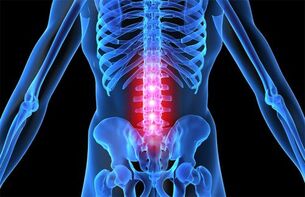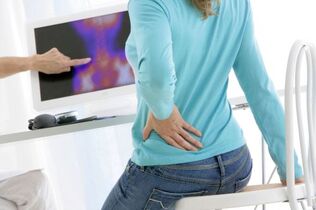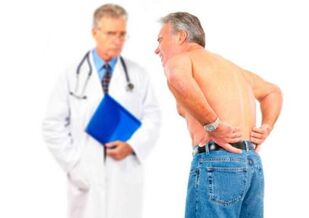A considerable amount of a person falls on the lower back, and when the load is lifted, distorted, from a long static position, an additional stress is created in it. Excessive load, wrong lifestyle leads steadily to the degradation of the musculoskeletal system: the vertebrae and discs between them, which function as shock absorbers. From this point on, it is worth seeking information about osteochondrosis of the lumbar spine: symptoms and treatment. Why does degradation of the spinal joints occur?

Degradation of the musculoskeletal system occurs as follows: the natural shock absorber of the spine loses its elasticity, shrinks, spreads beyond its natural boundaries, the pressure from other vertebrae, organs, ligaments also increases. Let us describe those who are prone to acquire such pathology. Osteochondrosis of the lumbar spine can be seen in humans:
- Early generations whose suffering was similar;
- Having hormonal disorders;
- Individual predisposition to develop such diseases (for example, congenital structure of the spine);
- Those who neglect proper nutrition. At the table every day a person should take a balanced diet with healthy fats, vitamins, proteins;
- Those who have a sedentary job: sit for a long time or stay in one place for a long time;
- Experiencing a sharp and heavy load on the back, for example: weightlifters, loaders, people while working in the garden;
- Having diseases of digestion, metabolism, pelvic organs;
- Traumatized (pulled hard behind his back, hit sideways, fell, bent);
- Have reached the age of 30;
- Diabetes.
If there are signs of lumbar osteochondrosis, which are described in the section below, then some habits should be avoided:
- slit;
- tym;
- take a bent pose for a long time;
- moves slightly;
- pini alcohol;
- stays without work breaks;
- dress not for the weather, allow the body to cool.
Important. Any ligament disorder is exacerbated by the presence of excess weight. With excess weight, the load on the lower body increases and the lumbar region, overcrowded with fat, is massaged a lot.
Stages of the course of the disease, its signs

At first, there is periodic mild pain that increases with physical exertion. This concern suggests that it is time to pay attention to osteochondrosis of the lumbar spine. Right now, the intervertebral discs (the spinal disc is the channel through which the spinal cord and the fibrous rings around it) are degrading. Further, the distance between the vertebrae is reduced, the nerves are tightened. The pain becomes severe, affecting not only the back but also the hips, gluteal muscles. In the third stage, the fibrous rings are destroyed, which leads to the formation of a spinal hernia, irreversible curvature and pain is constantly present. The fourth stage leads to disability. The special classification of osteochondrosis of the lumbar spine includes:
- pain;
- ischemic syndrome;
- radicular syndrome;
- vertebral syndrome;
- ossification of overcrowded tissue.
Pain sensations have a different degree and character of severity: lumbago, for example, is called lumbago; constant, aggravated by stress, lumbodinia; The spread along the lower parts of the body is called lumboischialgia. In case the back diseases are not treated, the vertebrae gain very free movement in the spine. There is a compression of the nerve roots when it removes loads and immediate actions, then the pain from the lower back goes away but moves to other parts of the body, for which the nerve is responsible. Unconsciously, we change position, adjusting so that the pain occurs less in the back, but at the same time the walking and flexion of the spine inevitably change. All of this refers to radicular syndrome, which starts as irritation, and then becomes inflammatory. Signs of lumbar spine osteochondrosis with radicular syndrome:
- Excessive fatigue in the back muscles;
- change of back curvature;
- gait changes;
- swelling of the lower extremities;
- pain in one or both legs;
- severe pain;
- temporary loss of foot sensitivity;
- periodically prolonged constipation; men
- have problems with bullying;
- menstrual irregularities in women;
- body intoxication;
- blood stasis.
You may notice that during the holidays, painful sensations appear and when you do exercises on the back, they calm down. Already at this stage it is worth seeking a doctor: a chiropractor, surgeon, neurologist, traumatologist (since the causes of osteochondrosis of the lumbar spine include trauma). If you let the disease take its course, the problem will increase, being added by various companions:
- heat;
- mpirje;
- sweating;
- tingling sensation;
- chills;
- goose bun;
- impotence;
- colic in the intestine.
The back muscles lose tone, and this leads to a general loss of human motor functions. With a particularly dangerous course of radicular syndrome, paralysis will occur. Ischemic syndrome is associated with radicular. At first, the squeezing of blood flows is periodic, but then such squeezing leads to spasms. You can notice them during normal walking - walk with pain, if you stop, it does not hurt. The main degradation occurs inside and is not visible to the naked eye - blood flow does not provide all the pelvic organs with the necessary supply. There may be pain in the buttocks, thighs and then gluteal muscle paralysis may occur. Vertebral syndrome involves a change in the skeleton, the blood vessels themselves.
Important. The symptoms of lumbar osteochondrosis in women are inextricably linked to the hormonal background, the physiological characteristics of the body. Occurrence of painful sensations, inappropriate behavior is affected by wearing inappropriate shoes: on very strong or very soft heels; very high heel or very low heel.
Diagnosis of disease stages

It can be very difficult even for a doctor to classify and name the stage of the disease during the external examination. Initially, a neurologist may diagnose:
- continuous curvature of the spine;
- pain on touch;
- sitting on foot;
- gluteal area asymmetry;
- Michaelis diamond change.
But the most accurate diagnosis can only be made with the results:
- computed tomography (CT). The most optimal option for determining the degree of disease development, allowing the assessment of the stage of degeneration of the spine.
- X-ray shots. According to them, it is possible to determine the presence of a disease, but it is not always possible to determine the degree of development of damage to nerve fibers and blood vessels.
- magnetic resonance. Quite long (from half an hour to an hour), an expensive procedure, which also provides the most complete details of what is happening to the nerve roots and blood vessels.
Thus, the doctor can finally judge about osteochondrosis of the lumbar spine: symptoms and treatment only with the results of apparatus research. Low back pain that is not associated with an intervertebral disc disorder is caused by colds, kidney cold, menstrual cycle, or back muscle pain.
Important. CT, X-ray examinations are unacceptable for pregnant women. CT is unsafe for: 1) children under 14 years; 2) people with iodine allergies.
Medical treatment
The causes of the onset of the disease, its characteristics are considered above, now we return to the second point of lumbar spine osteochondrosis: symptoms and treatment. The longer you ignore the body's signals, the faster the disease will go further. The farther from the beginning, the more medications and procedures will need to be applied. Treatment objectives:
- identify, eliminate the causes of scratches on the roots, blood vessels of the spine;
- restores skin sensitivity;
- to prevent further development of pathology;
- start the body processes for self-healing;
- strengthening a person's muscle tone;
- restore the function of the internal organs of the small pelvis;
- return the normal flow of the lumbar vertebrae.
If you experience any concerns, see your doctor. The first thing to do at the first symptoms is to pay attention: a bed (a wide choice of orthopedic mattresses to be chosen individually), a pillow (can not fit you in size or softness), sleeping position, motor activity. At home, without a doctor's examination, osteochondrosis of the lumbar spine can be treated only with bed rest. Therefore, a visit to a doctor is mandatory. In the remission phase and the acute phase of the disease, various medications are taken. In the final stage, medicines are used to relieve pain, free the nerves from vertebral mites, and eliminate inflammation. Describe: - blockages; - glucocorticoids; - chondroprotectors; - myo-laxatives; - non-steroidal anti-inflammatory drugs (NSAIDs).

The last group of drugs, in addition to relieving pain, fights with excess body temperature, edema, inflammation. Such funds can be: rectal, for internal use, injection, external. Treatment of lumbar spine osteochondrosis most often begins with NSAIDs:
- Diclofenac;
- Piroksikam;
- Ibuppofen;
- Himekulidi;
- Hapoksi;
- Dexketoprofen;
- Meloxicam;
- Aceclofenac.
Anti-inflammatory drugs in this list are various ointments, tablets, gels. Some tablet NSAIDs have contraindications for those with ulcers or gastritis. Muscle relaxants relieve joint stiffness and involuntary back muscle contractions by temporarily lowering muscle tone. This group of drugs includes tizanidine, tolperizone hydrochloride. When there is an opportunity to preserve the intervertebral disc, chondroprotectors are prescribed, which should serve to restore the annulus fibrosus. The course of taking such a group of drugs is very long - at least 1. 5 months, and the results can be seen only after a year. They try to avoid the appointment of glucocorticoids, as they have side effects of taking them, as this group of drugs belongs to steroid hormones. They should be taken under the supervision of the attending physician by completing all prescriptions, as only a specialist knows how to cure lumbar osteochondrosis. An example of such a drug is hydrocortisone. Blockages are not medication in themselves, but they are a powerful local pain reliever. The technique is as follows: inserting an injection pain reliever (IO) or a combination of IO with a glucocorticoid drug into the pain area. Blockages do not have medicinal properties, but they can be addictive, which will lead to loss of sensitivity to these drugs. If injected frequently, the muscles around the injection may atrophy. Therefore, when acute pain is reduced by this method of treatment, the patient prescribes medications that are created to restore damaged tissue, blood flow, and help improve muscle tone and nerve fibers. This:
- Chondroprotectors, which have an overall strengthening effect on bone tissue, normalize cartilage tissue metabolism.
- Vitamins that help restore nerve capacity.
- Biogenic preparations that encourage the body to heal itself;
- Vascular drugs that dilute the blood to improve the nutrition of internal organs.
During treatment, along with the main medication, antidepressants are prescribed. Here's how to treat lumbar osteochondrosis while reducing acute pain:
- apply external warming, analgesic, anti-inflammatory agents;
- do special exercises for the back;
- go for a massage;
- leads a gentle lifestyle for the back;
- put on a belt corset when exercising.
Massage, exercise therapy, physiotherapy and alternative treatments.

Relatively inexpensive, effective methods of combating shock absorber degradation are physiotherapy exercises, massage, physiotherapy. A real massage can only be done by a professional with a medical education, so a simple visit to beauty salons is not suitable for patients. Each stage of the disease requires a different pressure and technique. With proper therapy, muscle spasm disappears, the muscular frame of the back strengthens and the pain gradually disappears. Physiotherapy is applicable only in the process of mitigating painful processes or when they are absent (to maintain the movement of the vertebrae). Gymnastics is chosen individually, based on age, condition of the person, the stage of development of the disease. The productivity of therapeutic exercises depends directly on the quality of performance and frequency: they must be done systematically. It is recommended to rest at home, lying on your back, bending your legs, placing a small roller under your lower back. The healing process is monitored with the help of X-ray, tomographic surveys. Physiotherapy treatments are prescribed during remission and exacerbation. Methods such as:
- acupuncture. An ancient method of treating pain, based on stimulating acupuncture points with thin needles. The procedure relieves spasms, reduces pain, completely eliminates it, reduces tissue edema;
- ultraviolet radiation, which stimulates the body to absorb calcium;
- ampilpus, named by the respective device. The treatment procedure is as follows: the plates of the apparatus are fixed to the back, and the corresponding therapeutic current with different parameters flows through the plates;
- laser therapy. Laser rays relieve pain, heal, stop inflammation in the lumbar vertebrae;
- darsonvalization. The method is designed to improve blood circulation, to dilate blood vessels, to stimulate nerve endings;
- phonophoresis treats with ultrasound, stimulating blood flow to the muscular part of the dorsal region.
Each method has its own contraindications. More is more difficult with traditional medicine. Official medicine still does not know that midwives grandmothers know how to treat lumbar osteochondrosis. Therefore, if a friend advises you to put compresses made of burdock soup, take coniferous baths, you should consult your doctor. For anesthesia, a method such as hirudotherapy is used, but the caterpillars are hidden behind this name, so doctors advise you to be careful with this method of treatment.
Surgical Problem Solving
In some cases, it is no longer possible to do without surgery. With advanced intervertebral hernias, neurological surgeons use microdiscectomy. The operation removes the damaged disc. If there are no contraindications, then doctors can perform nucleoplasty, which has many advantages:
- Does not require cuts;
- The operation lasts up to 30 minutes;
- No restrictions on surgical procedures.
Important. To maintain the movement of the spine, strengthen the back muscles, it is recommended to do yoga, swimming, Pilates. Running produces a shock load on the vertebrae, so at the first sign of lower back pain, brisk running should be abandoned.













































